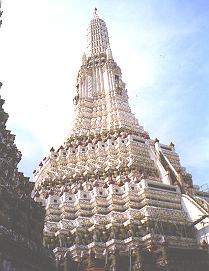This is the most important monument in the temple. King Rama II considered that the original prang which
16 metres in height should be reconstructed as the glory of the city, but he passed away shortly after beginning the task. King Rama III completed the structure and
crowned it with a multi-pronged bronze pinnacle. He died before the edifice could be dedicated. This task was performed by King Rama IV.
It is 81 metres high and iis surrounded by smaller prangs and mondops on eash side and in between. The Phra Buddha Prang, as the great central tower is called,
has three circum-ambulatory galleries running around it, which can be reached by climbing any one of the four very steep staircases. Above each staircase there s a
niche with a figure of Indra on his three-headed elephant Erawan.
The crown on the summit was originally made to be given to the presiding Buddha image at Wat Nang Nong".
When the nine-pronged finial was to be rised, King Rama III ordered the crown to be placed above it. It was rumoured then that this action of his was a sign
indication to the people the "Prince Mongkut" (meaning "Crown") was to succeed him. Prince Mongkut did indeed become Rama IV.
For small prangs surround the main one in the centre. Statues of Phra Phai, the wind-god on his white horse are placed in each niche on these. Statues of giants
and monkeys support the Mondop and the five Prangs as Caryatides. /kinnaras and Kinnaris are set in relief in niches all the way round of the first gallery.
On the ground around the prangs there are Chinese sculptures both in the forms of human beings and animals. In the eastern wall there are three gates
and two along the western wall. On top of these five gates the royal emblems of each king from King Rama I to King Rama V are to be seen.
On the fourth base of circumambultion are four replicas of the prang at each of the corners.
On the third circumambultion base in each of the four directions there is a Mondop containing depictions of the four most important episodes in the life of the Buddha.
The one in the north is the scene of the birth of the Buddha with his royal mother Queen Siri Maha Maya standing and holding the branch of a Sala tree. The newly born
Buddha stands in the middle of a giant lotus flower raising his right hand and declaring himself and extra-ordinary being. The one in the east is of his Enlightenment,
showing three seated Buddha images. The one in the middle is shaded by a Naga's hood; those on the sides are in the gesture of subduing Mara, one under Bodhi tree,
the mother under a banyan tree. The Mondop in the south contains the scene of the Buddha giving the first sermon to his five disciples who are seated with hands
folded in the gesture of paying homage. In the Mondop in the west the Buddha enters Nirvana, reclining between two Sala trees and surrounded by his mourning followers.
The second circumambultion base is decorated with kinnara and monkey caryatides in niches.
On the first circumambultion gallery at the top figures of Brahma seem to raise the prang. At each of the four corners there are small prangs, inside the niches of
which statues of Indra riding on his three-headed elephant Erawan. On top of these there are Vishnus riding on Garudas
The top of the monument bears a golden crown.
These circumambultion galleries are connected by stair-cases in the four cardinal directions.
The main prang, small prangs, mondops, porches and enclosure walls are all decorated with pieces of broken porcelain of varieties of colours. Some are in Thai-style flame patterns
while others are in the form of flowers. Bencharong ware is also used to decorate the surface of the prang. This type of decoration on the surface of architecture has been popular since the time of King Rama III.
|





